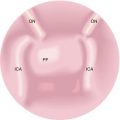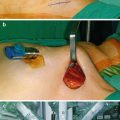Causes of primary hyperaldosteronism
Percentage of cases
Remarks
Aldosterone-producing adenoma (APA)
~35 %
Original pathology described by Conn
Bilateral idiopathic adrenal hyperplasia (BAH)
~60 %
–
Primary unilateral adrenal hyperplasia
2 %
–
Pure aldosterone-producing adrenocortical carcinoma
<1 %
–
Familial aldosteronism (FH-I and FH-II)
AD, fusion of ACTH-responsive 11-beta-hydroxylase gene promoter to aldosterone synthase gene
1. Type I – glucocorticoid remediable
<1 %
2. Type II – familial aldosteronoma or hyperplasia
<2 %
Ectopic aldosterone-producing adenoma/carcinoma
<0.1 %
Ovarian and renal tumors
Causes of secondary hyperaldosteronism
Disorders of edema
1. Cardiac failure
2. Liver failure/cirrhosis
3. Nephrotic syndrome
States of reduced renal perfusion
1. Renal artery stenosis
2. Advanced atherosclerosis
3. Malignant hypertension
Renin-producing tumors
Pregnancy
Secondary hyperaldosteronism results from excessive activation of the RAS without a primary disorder of the zona glomerulosa itself (Table 3.1).
Epidemiology of Conn’s Syndrome
Incidence is unknown.
Prevalence of 3.4–11.2 % has been demonstrated in hospital-treated patients with essential hypertension.
Up to 19 % of patients hospitalized for the treatment of their hypertension have primary hyperaldosteronism.
The prevalence of the disease increases with the severity of the hypertension.
Affects young adults between 30 and 50 years of age.
Female to male ratio 3:1.
No specific ethnic distribution.
Presentation (See Chap. 1)
Typical early presentation with moderate hypertension
Hypokalemia.
Normokalemia occurs in up to 50 % of patients and, therefore, does not reliably exclude the need to screen for PA.
Hypernatremia (serum Na+ >145 mmol/l) without peripheral edema.
Alkalosis.
Symptoms from aldosterone-induced organ damage such acute coronary syndromes, stroke, obesity, and insulin resistance/diabetes mellitus.
Indications for screening for PA in a hypertensive patient include:
Early onset (<20 years)
Resistance to two or more medications
Severe hypertension (systolic blood pressure >160 or diastolic blood pressure >100 mmHg)
Hypertension with spontaneous hypokalemia (or secondary to low-dose diuretic)
Hypertension associated with an adrenal incidentaloma
Evaluation for secondary causes of hypertension
Family history of hypertension and PA
Diagnostic Evaluation
Accurate diagnosis depends on biochemical tests and radiological investigations.
Liaise with endocrinologists.
Basic Biochemical Tests: (See Chap. 1)
Plasma aldosterone concentration (PAC, pmol/L)
Plasma renin activity (PRA, pmol/ml/hour)
Active renin concentration (ARC, pmol/ml/hour)
PAC: PRA ratio
Hypertension during the period off these drugs can be managed with alpha-adrenergic and non-dihydropyridine calcium channel blockade with medication such as doxazosin and diltiazem together with potassium supplements.
The PAC: PRA ratio is a screening test with variable diagnostic accuracy and a sensitivity and specificity of between 64–100 % and 87–100 %.
Patients meeting the diagnostic criteria for PA based on a positive PAC: PRA test should undergo confirmatory testing before a definitive diagnosis of primary aldosteronism is made.
Confirmatory Testing
Suppression of aldosterone production after expansion of intravascular volume is the pathophysiological basis of most confirmatory testing. A positive test is characterized by a paradoxical unsuppressable aldosterone level. Three tests have been employed:
Saline Suppression Test (SST)
The most widely performed test.
After stopping all interfering drugs as above and a low-sodium diet for 3 days, 2 l of normal saline are given intravenously over 4 h.
Measurement of plasma aldosterone and urinary aldosterone and sodium levels at the 4 h time point.
A PAC level of >10 pmol/L, urinary aldosterone secretion >12 ug/24 h, and with urinary sodium >200 mmol/24 h confirm the diagnosis of PA.
This test is contraindicated in patients with severe uncontrolled hypertension, renal and cardiac failure, arrhythmia, or severe hypokalemia.
Fludrocortisone Suppression Test (FST)
Now infrequently used because it requires hospitalization, may be associated with severe hypokalemia and deterioration in cardiac function.
Captopril Suppression Test (CST)
Now infrequently used also due to false-negative rates of up to 36 %.
Lateralization Studies
The therapeutic pathway of the patient depends on whether the cause of the hyperaldosteronism is unilateral or bilateral. All patients with positive biochemical testing require a dedicated, high-resolution computed tomography (CT) scan of the adrenal glands with thin collimation (2–3 mm slices). Possible findings on CT may include:
Normal-appearing adrenal glands
Stay updated, free articles. Join our Telegram channel

Full access? Get Clinical Tree





